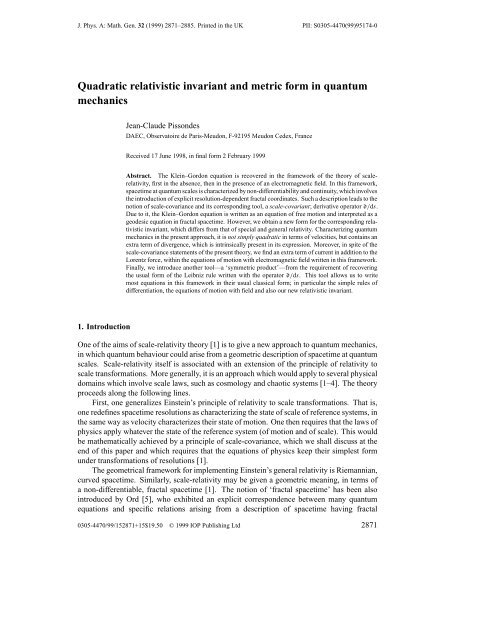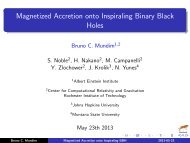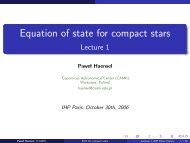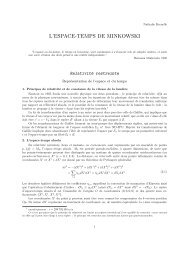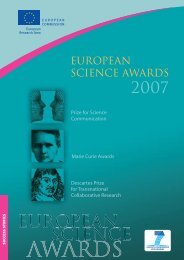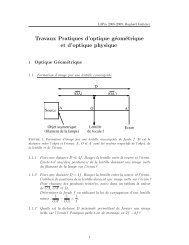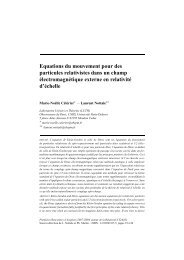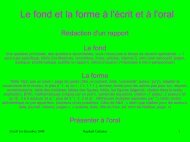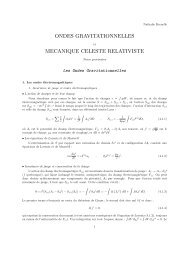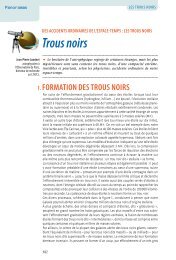J. Phys. A: Math. Gen. 32 (1999) - LUTH - Observatoire de Paris
J. Phys. A: Math. Gen. 32 (1999) - LUTH - Observatoire de Paris
J. Phys. A: Math. Gen. 32 (1999) - LUTH - Observatoire de Paris
You also want an ePaper? Increase the reach of your titles
YUMPU automatically turns print PDFs into web optimized ePapers that Google loves.
J. <strong>Phys</strong>. A: <strong>Math</strong>. <strong>Gen</strong>. <strong>32</strong> (<strong>1999</strong>) 2871–2885. Printed in the UK PII: S0305-4470(99)95174-0<br />
Quadratic relativistic invariant and metric form in quantum<br />
mechanics<br />
1. Introduction<br />
Jean-Clau<strong>de</strong> Pisson<strong>de</strong>s<br />
DAEC, <strong>Observatoire</strong> <strong>de</strong> <strong>Paris</strong>-Meudon, F-92195 Meudon Ce<strong>de</strong>x, France<br />
Received 17 June 1998, in final form 2 February <strong>1999</strong><br />
Abstract. The Klein–Gordon equation is recovered in the framework of the theory of scalerelativity,<br />
first in the absence, then in the presence of an electromagnetic field. In this framework,<br />
spacetime at quantum scales is characterized by non-differentiability and continuity, which involves<br />
the introduction of explicit resolution-<strong>de</strong>pen<strong>de</strong>nt fractal coordinates. Such a <strong>de</strong>scription leads to the<br />
notion of scale-covariance and its corresponding tool, a scale-covariant; <strong>de</strong>rivative operator d/ds.<br />
Due to it, the Klein–Gordon equation is written as an equation of free motion and interpreted as a<br />
geo<strong>de</strong>sic equation in fractal spacetime. However, we obtain a new form for the corresponding relativistic<br />
invariant, which differs from that of special and general relativity. Characterizing quantum<br />
mechanics in the present approach, it is not simply quadratic in terms of velocities, but contains an<br />
extra term of divergence, which is intrinsically present in its expression. Moreover, in spite of the<br />
scale-covariance statements of the present theory, we find an extra term of current in addition to the<br />
Lorentz force, within the equations of motion with electromagnetic field written in this framework.<br />
Finally, we introduce another tool—a ‘symmetric product’—from the requirement of recovering<br />
the usual form of the Leibniz rule written with the operator d/ds. This tool allows us to write<br />
most equations in this framework in their usual classical form; in particular the simple rules of<br />
differentiation, the equations of motion with field and also our new relativistic invariant.<br />
One of the aims of scale-relativity theory [1] is to give a new approach to quantum mechanics,<br />
in which quantum behaviour could arise from a geometric <strong>de</strong>scription of spacetime at quantum<br />
scales. Scale-relativity itself is associated with an extension of the principle of relativity to<br />
scale transformations. More generally, it is an approach which would apply to several physical<br />
domains which involve scale laws, such as cosmology and chaotic systems [1–4]. The theory<br />
proceeds along the following lines.<br />
First, one generalizes Einstein’s principle of relativity to scale transformations. That is,<br />
one re<strong>de</strong>fines spacetime resolutions as characterizing the state of scale of reference systems, in<br />
the same way as velocity characterizes their state of motion. One then requires that the laws of<br />
physics apply whatever the state of the reference system (of motion and of scale). This would<br />
be mathematically achieved by a principle of scale-covariance, which we shall discuss at the<br />
end of this paper and which requires that the equations of physics keep their simplest form<br />
un<strong>de</strong>r transformations of resolutions [1].<br />
The geometrical framework for implementing Einstein’s general relativity is Riemannian,<br />
curved spacetime. Similarly, scale-relativity may be given a geometric meaning, in terms of<br />
a non-differentiable, fractal spacetime [1]. The notion of ‘fractal spacetime’ has been also<br />
introduced by Ord [5], who exhibited an explicit correspon<strong>de</strong>nce between many quantum<br />
equations and specific relations arising from a <strong>de</strong>scription of spacetime having fractal<br />
0305-4470/99/152871+15$19.50 © <strong>1999</strong> IOP Publishing Ltd 2871
2872 J-C Pisson<strong>de</strong>s<br />
properties. Note that the word ‘fractal’ is used in the present approach in its general meaning<br />
[6] of a set that shows structures at all scales and so becomes explicitly scale-<strong>de</strong>pen<strong>de</strong>nt:<br />
in such a framework, resolutions are consi<strong>de</strong>red to be intrinsic characteristics of spacetime<br />
itself. Moreover, the absence of smooth trajectories in fractal spacetime requires that the<br />
notion of point-particle be modified. As has already been indicated in the work of Ord [5], the<br />
modification suggested [1, 8] links wave particle duality to fractal structure on trajectories in<br />
such spacetime.<br />
Some features of non-relativistic quantum mechanics have already been recovered in such<br />
a framework, being <strong>de</strong>scribed as a manifestation of the non-differentiability and ‘fractality’<br />
of space [1, 5, 8]. Extending and correcting the results obtained in [9], we shall show in<br />
this paper that one can also obtain similar results in the relativistic case. Namely, the free<br />
particle Klein–Gordon equation can be recovered from the equations of free motion ‘in a<br />
non-differentiable, fractal spacetime’, interpreted as geo<strong>de</strong>sic equations of such spacetime.<br />
Associated with it, we find the form of the relativistic invariant, characterizing quantum<br />
mechanics in our present interpretation. We also consi<strong>de</strong>r the electromagnetic case where<br />
we show that the corresponding equations of motion—leading to the Klein–Gordon equation<br />
with an electromagnetic four-potential—contain an extra term of current in addition to the<br />
usual term of Lorentz force. We conclu<strong>de</strong> this paper with a discussion about scale-covariance,<br />
which could be implemented in this framework by the use of a ‘scale-covariant <strong>de</strong>rivative’<br />
d/ds. Thanks to it, we should be able to <strong>de</strong>duce equations which are scale-covariant and then,<br />
equations of quantum mechanics. We find that the prescription postulated in [1–4, 9], which<br />
consists of replacing the total <strong>de</strong>rivative d/ds in classical equations by d/ds, has actually to be<br />
exten<strong>de</strong>d and cannot be used directly in all cases. Introducing a ‘symmetric product’ f ◦ dg,<br />
we show that such an extension is possible and that we can write most of the equations of this<br />
framework in their usual classical form.<br />
2. Schrödinger equation: a ‘geo<strong>de</strong>sic equation’ in fractal space<br />
Let us first recall how, following [1, 2], the notion of geo<strong>de</strong>sics in a non-differentiable space<br />
is introduced. The basic assumption of the scale-relativistic approach, consists of i<strong>de</strong>ntifying<br />
the quantum properties of the particles and the concept of quantum particles itself, with the<br />
fractal properties of spacetime at very ‘small scales’. As we shall see, general relativity is<br />
taken as a mo<strong>de</strong>l at almost all levels of the theory. First, one uses the notions of spacetime<br />
geometry, geo<strong>de</strong>sics and finally, the i<strong>de</strong>a of general covariance. Second, one tries to construct<br />
corresponding mathematical tools to achieve these concepts, by analogy with the general<br />
relativistic tools, which are those of a Riemannian and differentiable geometry. Concerning<br />
the notion of geo<strong>de</strong>sics, two main problems were encountered in this approach. (i) Fractal<br />
trajectories have an infinite length. The first one is then to <strong>de</strong>fine a geo<strong>de</strong>sic, which must<br />
be a minimal curve. (ii) Moreover, geo<strong>de</strong>sic equations are written in terms of differential<br />
equations. How can we write such equations, if the spacetime coordinates are not <strong>de</strong>rivable?<br />
The <strong>de</strong>scription proposed in [1, 2], is supposed to solve both problems at the same time. As<br />
a first step, Nottale and Schnei<strong>de</strong>r [10] showed that we could <strong>de</strong>fine (in fact, for a particular<br />
sample) an intrinsic curvilinear coordinate on a fractal curve by using non-standard analysis<br />
(NSA). This allowed one to work with infinitesimal and infinite quantities and this coordinate<br />
can be naturally renormalized to a finite value: that is, the length of a fractal curve can be<br />
written as the produce of a finite and of an infinite part (see later). The finite part is equivalent<br />
to taking the D-measure of the curve (where D is its fractal dimension) instead of its standard<br />
length (of topological dimension DT = 1). Actually, even if the length of each curve among<br />
a set of fractal curves is infinite, the ratio of the length of two curves remains finite provi<strong>de</strong>d
Quadratic relativistic invariant and metric form 2873<br />
their fractal dimension is the same. Then, the lengths of different curves can be compared and<br />
a minimal curve can be <strong>de</strong>fined, so that the concept of geo<strong>de</strong>sics keeps its meaning.<br />
The second step concerns the equivalence between this <strong>de</strong>scription and the explicit<br />
introducing resolutions in the <strong>de</strong>scription. Following [1, 2, 4], as a direct consequence<br />
of a Lebesgues theorem, which states that a curve of finite length is almost everywhere<br />
differentiable, we show that the length of an almost nowhere differentiable curve is a function<br />
of resolutions, L = L(ε) and diverges toward the small scales, i.e. L(ε) →∞when ε → 0.<br />
In the case of a coordinate measured along a fractal curve with constant fractal dimension<br />
D, this length can be written as<br />
L(τ, ε) = L(τ)(λ/ε) δ<br />
where δ = D − 1. Here ε is a length-resolution and τ is a parameter along the curve. One<br />
recovers the non-standard <strong>de</strong>scription by taking an infinitesimal value for ε. In this case ε−δ is<br />
infinite, while L(τ)λδ , which can be i<strong>de</strong>ntified with the D-measure of the fractal coordinate,<br />
remains finite. The optimization process leading to the <strong>de</strong>finition of geo<strong>de</strong>sics could then be<br />
performed on L(τ).<br />
More generally, one can introduce an upper transition scale λ toward scale in<strong>de</strong>pen<strong>de</strong>nce<br />
by writing the length variation as [1, 2]<br />
L(τ, ε) = L(τ)[1 + (λ/ε) δ ].<br />
In general, the transition may itself be a function of τ,λ = λ(τ). Such an expression is<br />
a solution of the simplest scale differential equation one can write for the variation of L<br />
with resolution, i.e. a first-or<strong>de</strong>r, renormalization group-like equation ∂L/∂ ln ε = β(L) =<br />
a + bL + ···. The transition scale λ then appears as a constant of integration.<br />
This <strong>de</strong>composition may also concern an elementary displacement on the fractal curve.<br />
Projecting on the three space axes, we write this as<br />
dX i = dx i +dξ i =v i (t) dt + ζ i λ 1−1/D |c dt| 1/D<br />
where dξ i <strong>de</strong>scribes the fractal behaviour, 〈ζ i 〉=0, 〈ζ iζ j 〉=δij . The length scale λ, as well<br />
as the velocity of light c, appears for dimensional reasons. Let ξ be a fractal function of t.<br />
Then, the expression of the variation δξ with respect to the resolution δt is given by<br />
D δξ<br />
=<br />
λ<br />
|δt|<br />
λ/c ⇒ δξ = λ1−1/D |cδt| 1/D .<br />
So, provi<strong>de</strong>d the i<strong>de</strong>ntification δt ≡ dt, we write for each coordinate axis<br />
dξ i = ζ i λ 1−1/D |c dt| 1/D<br />
such that<br />
〈 dξ i 〉=0 and 〈 dξ i dξ j 〉=δ ij λ 2−2/D |c dt| 2/D .<br />
This leads to the second term of the right-hand si<strong>de</strong> of the expression for dXi . As has been<br />
shown by Abbott and Wise [11], the special case when D = 2 corresponds precisely to the<br />
fractal dimension of typical quantum mechanical paths, <strong>de</strong>scribed by Feynman and Hibbs as<br />
curves which are continuous,butnon-differentiable (see, p 177, [12]). In the present approach,<br />
we assume that if paths show the properties to be ‘highly irregular on a fine scale’ and ‘nondifferentiable’<br />
(as we can read in [12]), it is because space(-time) itself has, at quantum scales<br />
these properties in an intrinsic manner.<br />
We have, however, to be careful that the previous relation is not the direct projection of the<br />
expression for L(τ, ε), after differentiation. Here xi is a differentiable mean coordinate, which<br />
corresponds to the usual ‘classical’ coordinate, while the full variable Xi is non-differentiable,<br />
since dXi /dt ∝ dt 1/D−1 , which is divergent when dt → 0 for D>1.
2874 J-C Pisson<strong>de</strong>s<br />
Now, the goal which we search is not to <strong>de</strong>scribe a given <strong>de</strong>terministic fractal trajectory,<br />
but instead to un<strong>de</strong>rstand the trajectories as being the geo<strong>de</strong>sics of a fractal space. Following<br />
[1, 2], we assume that the non-differentiability of space would imply that there will be an<br />
infinity of geo<strong>de</strong>sics coming in to any point and another infinity coming out from it. Two sets<br />
of geo<strong>de</strong>sics are introduced, assuming that the differential time reflection symmetry dt →−dt<br />
is broken by non-differentiability. Then we are led to replace the individual mean velocity vi by two velocity fields vi + {x(t),t} and vi− {x(t),t}.<br />
One of the important new features of scale relativity compared with similar approaches<br />
such as stochastic mechanics [13] consists of introducing a complex velocity field, which mixes<br />
the forward and the backward fields as [1]<br />
V i i v+ + v<br />
≡<br />
i i<br />
− v+ − v<br />
− i<br />
2<br />
i <br />
−<br />
≡ V<br />
2<br />
i − iU i .<br />
This choice is motivated by the constraint to recover a real field V and a vanishing imaginary<br />
field in the classical limit v+ = v−.<br />
The last step is to construct a ‘scale-covariant <strong>de</strong>rivative’, which <strong>de</strong>scribes the effects on<br />
physical quantities of the new geometric structure of space. The variation of a field f {x(t),t}<br />
during a time interval dt is given by df [1, 2], where<br />
d ∂<br />
= + V ·∇−icλ<br />
dt ∂t 2 <br />
in the special case when the fractal dimension is D = 2, which in<strong>de</strong>ed plays a critical role in<br />
such an approach [2, 4, 5, 11]. We are now able to write the equations of free motion ‘in fractal<br />
space’. One starts from the equations of geo<strong>de</strong>sics in Eucli<strong>de</strong>an space, i.e. the equations of<br />
inertial motion, dV /dt = 0 and one uses d/dt asa‘scale-covariant <strong>de</strong>rivative’. One obtains<br />
the free equations [1]<br />
dV ∂V<br />
= 0 ⇔ + V ·∇V−icλV<br />
= 0.<br />
dt ∂t 2<br />
We may also use the Euler–Lagrange equations. Given a complex Lagrange function in<br />
its usual form: L(x, V) = (1/2)mV2 , we write the Euler–Lagrange equations as in classical<br />
mechanics. We then obtain precisely the previous form, dV/dt = 0. The same can be said in<br />
both cases, in the presence of a potential φ(x). Our equations of motion then take the usual<br />
form of the Newton law: mdV/dt =−∇φand the corresponding Lagrange function becomes<br />
L(x, V) = (1/2)mV2 − φ.<br />
This equation can finally be transformed by introducing the wavefunction as another<br />
expression for the action, following the familiar ansatz<br />
ψ ≡ e iS/mcλ .<br />
Therefore, the complex velocity field is related to the wavefunction ψ by the relation<br />
V =−icλ∇(ln ψ). The replacement of V in the equations of motion with potential by this<br />
expression yields an equation which, once integrated, is the Schrödinger equation [1, 2]<br />
(cλ) 2<br />
2<br />
ψ +icλ∂ψ<br />
∂t<br />
φ<br />
− ψ = 0<br />
m<br />
with mcλ = ¯h.<br />
The Born interpretation of quantum mechanics would also be consistent with such an<br />
approach. A probability <strong>de</strong>nsity is <strong>de</strong>fined from the fluid of geo<strong>de</strong>sics, while the imaginary<br />
part of the geo<strong>de</strong>sic-Schrödinger equation writes ∂ρ/∂t + ∇·(ρV ) = 0, where ρ = ψψ † and<br />
where V is the real part of V. This is the continuity equation (which is now in this approach
Quadratic relativistic invariant and metric form 2875<br />
a part of the equations of the dynamics, more precisely the imaginary part of the Hamilton–<br />
Jacobi equation given in appendix A), so that ψψ † is easily interpreted as that probability<br />
<strong>de</strong>nsity. This has recently been evi<strong>de</strong>nced by numerical simulations due to Hermann [14], who<br />
obtained solutions to the Schrödinger equation without using it, by constructing trajectories<br />
directly from these equations of elementary displacements and by Ord and Deakin [15] who<br />
obtained a similar result using a binary symmetric random walk.<br />
Finally, let us mention the following important point, which we shall <strong>de</strong>tail in appendix A.<br />
If the Schrödinger equation without external potential (φ = 0) is written in this approach as free<br />
equations dV/dt = 0, we can show [20–22, 26] that the complex quantity which corresponds<br />
to the ‘energy’ in the free case, is not simply quadratic in velocities V. In<strong>de</strong>ed, its new form is<br />
Efree ≡ E − φ = 1<br />
2 mV2 − im cλ<br />
2 ∇·V.<br />
One can show that the divergence term is present intrinsically in this expression and has not to<br />
be seen as an external potential, which would be ad<strong>de</strong>d to a basic quadratic form corresponding<br />
to the kinetic energy in this framework.<br />
3. Klein–Gordon equation and ‘quadratic’ relativistic invariant<br />
Most elements of the approach summarized previously, as <strong>de</strong>scribed in [1, 2, 4], would remain<br />
correct in the motion-relativistic case, with the time differential element dt replaced by the<br />
proper time differential, ds. Now not only space, but the full spacetime continuum, is<br />
consi<strong>de</strong>red to be non-differentiable, then fractal. Consi<strong>de</strong>r a small increment dX µ of nondifferentiable<br />
four-coordinates along one of the geo<strong>de</strong>sics of the fractal spacetime. We assume<br />
that, because of non-differentiability, there will be an infinity of fractal geo<strong>de</strong>sics between any<br />
couple of events. This suggests jumping to a statistical <strong>de</strong>scription. As in the non-relativistic<br />
case, we can <strong>de</strong>compose dX µ in terms of a mean, 〈 dX µ 〉= dx µ =v µ dsand a fluctuation<br />
respective to the mean, dξ µ (such that 〈 dξ µ 〉=0 by <strong>de</strong>finition).<br />
As for the non-relativistic case, the supposed non-differentiable nature of spacetime would<br />
imply a more fundamental consequence, namely, the breaking reflection invariance at the<br />
infinitesimal level. If one reverses the sign of the proper time differential element, the mean<br />
velocity v+ becomes v− and there is no reason for these two velocities to be equal, in contrast<br />
to what happens in the classical, differentiable case. However, both choices of a reversed<br />
proper time element (−ds) and the initial choice (ds), have to be consi<strong>de</strong>red as equivalent for<br />
the dynamic stochastic <strong>de</strong>scription (see the discussion in [19]). Therefore, we assume that we<br />
have to consi<strong>de</strong>r both the forward (ds >0) and backward (ds
2876 J-C Pisson<strong>de</strong>s<br />
In stochastic mechanics, the expectation is taken on a previously <strong>de</strong>fined probability <strong>de</strong>nsity.<br />
Here, though it has yet to be rigorously <strong>de</strong>fined, the expectation would concern the infinite set<br />
of geo<strong>de</strong>sics. Once applied to x µ , they yield the forward and backward mean four-velocities<br />
d+<br />
d−<br />
ds xµ (s) = v µ +<br />
ds xµ (s) = v µ<br />
−. (3)<br />
As in the non-relativistic case [1], the forward and backward <strong>de</strong>rivatives (3) can be combined<br />
in terms of a complex <strong>de</strong>rivative operator [9]<br />
d<br />
ds ≡ (d+ +d−)−i(d+−d−)<br />
. (4)<br />
2ds<br />
When applied to the position vector, it yields a complex four-velocity<br />
V µ ≡ dxµ<br />
ds = vµ + + v µ<br />
−<br />
− i<br />
2<br />
vµ + − v µ<br />
−<br />
= V<br />
2<br />
µ − iU µ . (5)<br />
Let us now jump to the stochastic interpretation of the theory. This leads us to consi<strong>de</strong>r the<br />
question of the <strong>de</strong>finition of a Lorentz-covariant diffusion in spacetime. Forward and backward<br />
fluctuations, dξ µ<br />
±(s), are <strong>de</strong>fined, which are Gaussian with mean zero, mutually in<strong>de</strong>pen<strong>de</strong>nt<br />
and such that<br />
〈 dξ µ<br />
± dξ ν ± 〉=∓ληµν ds. (6)<br />
In this paper, we choose a (+, −, −, −) signature. It is not the purpose of this article to examine<br />
the difficulties which appear when we consi<strong>de</strong>r stochastic processes in the relativistic case, but<br />
as has been pointed out by Hakim [16], we cannot naively transpose to the relativistic case<br />
the usual classical <strong>de</strong>finitions of stochastic processes. Several authors have consi<strong>de</strong>red the<br />
extension of Nelson stochastic mechanics to the relativistic case and have introduced some<br />
specific notions to achieve as fairly as possible this extension. We may mention [17], where<br />
Dohrn and Guerra introduce two metrics; a ‘Brownian metric’ η µν , which is positive <strong>de</strong>finite<br />
and which is present in the expectation 〈 dW µ dW ν 〉∝η µν dτ of the stochastic process dW µ ;<br />
and a ‘kinetic metric’ gµν, which is used to write the kinetic term (1/2)gµνv µ + vν − in a stochastic<br />
Lagrangian. The compatibility condition between these two metrics reads gµνη µρη νλ = gρλ .<br />
We also refer the rea<strong>de</strong>r to the work of Zastawniak [18] and finally to Serva [19], who gives up<br />
Markov processes and consi<strong>de</strong>rs a covariant process that belongs to a larger class, known as<br />
‘Bernstein processes’. We do not claim here to end the discussion about relativistic stochastic<br />
processes, but we may keep in mind that the role played by the Laplacian operator in the<br />
non-relativistic case, is now played by the Dalembertian operator in the relativistic equations.<br />
So, we can show that the two forward and backward differentials of a function f(x,s) are<br />
written, assuming a Minkowskian metric (+, −, −, −) for classical spacetime:<br />
d±f<br />
ds =<br />
<br />
∂<br />
+ vµ ±∂µ ∓<br />
∂s λ<br />
2 ∂µ <br />
∂µ f. (7)<br />
In the following, we only consi<strong>de</strong>r s-stationary functions, i.e. functions that do not<br />
explicitly <strong>de</strong>pend on the proper time s. In this case the time <strong>de</strong>rivative complex operator<br />
finally reduces to [9]<br />
d<br />
ds = Vµ ∂µ +i λ<br />
2 ∂µ ∂µ. (8)<br />
Note the correction of sign with respect to [9]. The + sign of the Dalembertian comes from<br />
the choice of a metric signature (+, −, −, −) for the classical spacetime.<br />
Following [4, 9], the operator (8) would play the role, in the relativistic case of motion,<br />
ofa‘scale-covariant <strong>de</strong>rivative’. Therefore, we assume that the equations of motion of a free<br />
relativistic quantum particle, may be written as<br />
dV α<br />
ds<br />
= 0 (9)
Quadratic relativistic invariant and metric form 2877<br />
which are interpreted as the equations of free motion ‘in fractal spacetime’, or as geo<strong>de</strong>sic<br />
equations. Replacing now the <strong>de</strong>rivative operator in (9) by its expression (8), then using the<br />
expression for the complex four-velocity related to the wavefunction by Vν = iλ∂ν ln ψ, one<br />
obtains from (9) the free Klein–Gordon equation<br />
∂ ν<br />
<br />
λ 2 ∂µ <br />
∂µψ<br />
= 0. (10)<br />
ψ<br />
The <strong>de</strong>monstration proceeds by <strong>de</strong>fining a complex action S, as the non-relativistic case:<br />
ψ = e iS/mcλ . (11)<br />
Then, we link S to the complex four-velocity Vµ as in classical mechanics by<br />
−∂µS = mcVµ. (12)<br />
Using the following <strong>de</strong>rivation formulae<br />
∂ µ ψ<br />
ψ ∂µ<br />
ν <br />
∂ ψ<br />
=<br />
ψ<br />
∂µ ψ<br />
ψ ∂ν<br />
<br />
∂µψ<br />
=<br />
ψ<br />
1<br />
2 ∂ν<br />
µ <br />
∂ ψ ∂µψ<br />
ψ ψ<br />
µ <br />
∂ ψ<br />
∂µ +<br />
ψ<br />
∂µ ψ ∂µψ<br />
ψ ψ = ∂µ ∂µψ<br />
(13)<br />
ψ<br />
we obtain equation (10). So, the Klein–Gordon equation<br />
−¯h 2 ∂ µ ∂µψ = m 2 c 2 ψ (14)<br />
becomes an ‘integral of motion’ of the free particle, once λ is i<strong>de</strong>ntified with the Compton<br />
length of the particle<br />
λ = ¯h/mc. (15)<br />
The quantum behaviour <strong>de</strong>scribed by this equation and the probabilistic interpretation<br />
given to ψ would be reduced here to the <strong>de</strong>scription of a ‘free fall’ in fractal spacetime, in<br />
analogy with Einstein general relativity where a particle subjected to the effects of gravitation<br />
is <strong>de</strong>scribed as being in free fall in a curved spacetime. However, we shall find some important<br />
differences with general relativity, in particular in the counterpart of the usual quadratic<br />
invariant, as well as in the electromagnetic case.<br />
Without electromagnetic field, we can see the equations of motion (9) as ‘scale-covariant’,<br />
since the relativistic quantum equation written in terms of the complex <strong>de</strong>rivative operator d/ds<br />
has the same form as the equations of a relativistic macroscopic free particle, written with the<br />
usual <strong>de</strong>rivative d/ds.<br />
We now arrive at the main new result of this paper. Contrary to the hope expressed<br />
in [9], the quadratic relativistic invariant of special and general relativity V µ Vµ = 1isnot<br />
conserved in the present <strong>de</strong>scription of quantum mechanics. In<strong>de</strong>ed, we can show [20–22, 26]<br />
that the relativistic invariant associated with the free equations of motion (9) written with the<br />
operator (8) now takes the form<br />
V µ Vµ +iλ∂ µ Vµ = 1. (16)<br />
As the usual quadratic invariant g µν VµVν = 1 is directly related to the metric itself<br />
ds 2 = g µν dxµ dxν, the expression (16), which is not purely quadratic in terms of velocities,<br />
could a priori <strong>de</strong>fine a ‘metric form’ which characterizes quantum mechanics in the present<br />
picture. Following the aims of this approach, we would say that its new form reflects the<br />
internal structures of the spacetime at quantum scales. However, we recall that the principle<br />
of scale-covariance, which a priori requires that equations and relevant quantities of physics<br />
keep their simplest form at all scales, has been stated as a postulate in the introduction. So,
2878 J-C Pisson<strong>de</strong>s<br />
we cannot justify the change of the form of some equations by the geometry of space, after<br />
having postulated that they have to keep their usual form, when written in scale relativity<br />
theory. From our invariant (16), we can also write the relativistic Hamilton–Jacobi equation<br />
in this framework. In the absence of an electromagnetic field A µ , V µ and S are related by<br />
equation (12), so that (16) becomes<br />
(17)<br />
which is the form taken by the Hamilton–Jacobi equation in the present picture. Using this<br />
parametrization, it directly yields the Klein–Gordon equation.<br />
∂ µ S∂µS − imcλ∂ µ ∂µS = m 2 c 2<br />
4. Klein–Gordon equation with electromagnetic field<br />
Let us now consi<strong>de</strong>r a spinless particle in an electromagnetic field. In the presence of an<br />
electromagnetic field, (16) still applies, but with V µ now given by<br />
mcV µ <br />
=− ∂ µ S+ e<br />
c Aµ<br />
(18)<br />
so that we obtain the Hamilton–Jacobi equation [20–22, 26]<br />
<br />
∂ µ S + e<br />
c Aµ<br />
<br />
∂µS + e<br />
c Aµ<br />
<br />
− imcλ∂ µ<br />
<br />
∂µS + e<br />
c Aµ<br />
<br />
= m 2 c 2<br />
(19)<br />
which is the electromagnetic counterpart of (17). In a consistent way, equation (19) is equivalent<br />
to<br />
<br />
imcλ∂ µ − e<br />
c Aµ<br />
<br />
imcλ∂µψ − e<br />
c Aµψ<br />
<br />
= m 2 c 2 ψ (20)<br />
in the electromagnetic case. We recognize here the free and electromagnetic Klein–Gordon<br />
equations, once the i<strong>de</strong>ntification λ = ¯h/mc is ma<strong>de</strong>.<br />
Let us now try to write the corresponding complex equations of motion written with the<br />
operator (8). Taking the partial <strong>de</strong>rivative of (16), we find<br />
<br />
V µ +i λ<br />
2 ∂µ<br />
<br />
∂αVµ =0. (21)<br />
Without electromagnetic field, due to the fact that V µ is a gradient, we have ∂αVµ = ∂µVα.<br />
Therefore, we recover from (21) the free equations written at the beginning of this section<br />
dVα<br />
= 0. (22)<br />
ds<br />
In the presence of an electromagnetic field, we can <strong>de</strong>rive from the expression for the<br />
complex four-momentum the following relation<br />
mc(∂αVµ − ∂µVα) =− e<br />
c Fαµ. (23)<br />
Substituting ∂αVµ in (21), we find the complex equations of motion [20–22, 26]<br />
mc dVα e<br />
=<br />
ds c Vµ Fαµ +i λe<br />
2c<br />
∂µ Fαµ. (24)<br />
We recognize here a complex equation that generalizes the fundamental relation of classical<br />
relativistic electrodynamics. Its real part is i<strong>de</strong>ntical to the equation proposed by Serva [19]<br />
and Zastawniak [18] (see also Ord [23]), since the real part of our complex acceleration<br />
is Nelson stochastic acceleration [1, 2]. However, its imaginary part contains an additional<br />
imaginary term of current [20–22], which was a priori not expected precisely because of<br />
scale-covariance postulated in [1–4, 9]. We have to mention the work of <strong>de</strong> la Pena-Auerbach
Quadratic relativistic invariant and metric form 2879<br />
and Cetto [27], where the non-relativistic counterpart of our current term has been found in the<br />
framework of the stochastic approach in<strong>de</strong>pen<strong>de</strong>ntly from our work. Because of the presence<br />
of this extra term, these equations of motion (24) are not <strong>de</strong>duced from their classical—<br />
i.e. macroscopic—counterparts: mc(dVα/ds) = (e/c)(dx µ /ds)Fαµ, by applying directly the<br />
substitution d/ds → d/ds within these equations, as it is required in [1–4, 9]. In this sense,<br />
their form has changed and a strict scale-covariance is lost. We shall show in the next section<br />
that we can recover the usual expected form by introducing a new tool.<br />
5. Leibniz rule, symmetric product and ‘scale-covariance’<br />
We will now show that it is possible to introduce an additional tool, which allows us to write<br />
the equations of motion with electromagnetic field in their usual classical form and go further<br />
in implementation of scale-covariance. This tool is in fact more than a simple notation. It may<br />
be seen as arising from the requirement of a fundamental property of the <strong>de</strong>rivative, namely the<br />
Leibniz rule. In<strong>de</strong>ed both complex <strong>de</strong>rivative operators, the non-relativistic and the relativistic<br />
one (8), contain a partial <strong>de</strong>rivative of second or<strong>de</strong>r in the presence of the Laplacian and<br />
Dalembertian operator, respectively. The presence of these operators does not allow us to<br />
write the rules of differentiation in their usual form [21, 22, 26]. Let us consi<strong>de</strong>r here only the<br />
relativistic case. If we consi<strong>de</strong>r two test functions f(x α )and g(x α )—such that their secondor<strong>de</strong>r<br />
<strong>de</strong>rivatives exist—and a composite function f {g(x α )}, the use of (8), applied to fg and<br />
f {g}, yields the two ‘rules’ of differentiation<br />
d(fg)<br />
ds<br />
dg df<br />
= f + g<br />
ds ds +iλ(∂µ f )(∂µg) (25)<br />
and<br />
df {g(xα )}<br />
= f<br />
ds<br />
′ {g} dg<br />
ds +iλ<br />
2 (∂µ f ′ {g})(∂µg). (26)<br />
One can actually show that formula (25) can be related to the canonical commutation relations<br />
of quantum mechanics [21]. So, we will introduce [21, 22, 26] a specific notation which allows<br />
us to write the formula (25) with the usual form of the Leibniz rule. A possible notation is<br />
f ◦ dg = f dg +i λ<br />
2 ds(∂µ f )(∂µg). (27)<br />
The previous expression is inspired from the ‘symmetric product’ introduced in the formalism<br />
of the stochastic integral, in particular to re-express the Fisk–Stratonovich integral (see Ikeda<br />
and Watanabe [24]). Thanks to (27), relations (25) and (26) now take their usual form<br />
d(fg) dg df<br />
= f ◦ + g ◦ (28)<br />
ds ds ds<br />
and<br />
df {g(xα )}<br />
= f<br />
ds<br />
′ {g}◦ dg<br />
. (29)<br />
ds<br />
Moreover, we are now able to <strong>de</strong>duce the right-hand si<strong>de</strong> of our complex equations of motion<br />
with field (24), by writing<br />
Fαµ ◦ dxµ dx<br />
= Fαµ<br />
ds µ<br />
ds +iλ<br />
2 (∂ρFαµ)(∂ ρ x µ dx<br />
) = Fαµ<br />
µ<br />
ds +iλ<br />
ρµ<br />
(∂ρFαµ)η<br />
2<br />
dx<br />
= Fαµ<br />
µ<br />
ds +iλ<br />
2 ∂µ Fαµ. (30)<br />
So, equations (24) now take the ‘scale-covariant’ form [21, 22, 26]<br />
mc dVα e<br />
=<br />
ds c Fαµ ◦ dxµ<br />
. (31)<br />
ds
2880 J-C Pisson<strong>de</strong>s<br />
Let us now examine another important case. In classical relativistic mechanics, the action S<br />
satisfies<br />
<br />
S =−mc ds<br />
which yields<br />
dS =−mc ds ⇔ dS<br />
=−mc. (<strong>32</strong>)<br />
ds<br />
However, we shall show that the counterpart of equation (<strong>32</strong>) written in the present picture<br />
takes a more complicated form. In<strong>de</strong>ed, because of relation (16), we have<br />
dS<br />
= −mc. (33)<br />
ds<br />
Using expressions (8) and (12), we get instead<br />
dS<br />
ds = Vµ ∂µS +i λ<br />
2 ∂µ <br />
∂µS =−mc V µ Vµ +i λ<br />
2 ∂µ <br />
Vµ<br />
(34)<br />
which becomes, due to (16)<br />
dS<br />
ds =−mc<br />
µ <br />
1+V Vµ<br />
. (35)<br />
2<br />
Actually, this expression may be <strong>de</strong>duced from the symmetric product itself (27). In<strong>de</strong>ed,<br />
remarking that we can write the fundamental interval as ds = V µ dxµ, let us formally write<br />
the differential of the complex action as<br />
dS =−mcV µ ◦ dxµ. (36)<br />
Expanding expression (27), we get<br />
− 1<br />
mc dS = Vµ dxµ +i λ<br />
2 ds(∂ρV µ )(∂ρxµ) = V µ dxµ +i λ<br />
2 ds(∂ρV µ )ηρµ<br />
= V µ dxµ +i λ<br />
2 ds∂µ Vµ<br />
(37)<br />
which may be rewritten as<br />
− 1 dS<br />
mc ds = Vµ Vµ +i λ<br />
2 ∂µ Vµ<br />
(38)<br />
which is equation (34). Now, let us recall that, in relativistic mechanics, the differential of the<br />
action dS is proportional to the interval dS. Starting from the real part of equation (35), one<br />
can show [26] that we have to consi<strong>de</strong>r the conformal transformation<br />
dσ = (1+Q) ds. (39)<br />
The quantity Q <strong>de</strong>notes the relativistic version of the ‘quantum potential’ <strong>de</strong>fined as<br />
Q ≡ λ 2 ∂µ ∂µρ1/2 ρ1/2 (40)<br />
which contains the <strong>de</strong>nsity probability ρ = ψψ∗ .<br />
Finally, let us consi<strong>de</strong>r the case of our relativistic invariant (16). As we have seen, the<br />
usual quadratic form V µ Vµ = 1 is lost. The extra divergence term iλ∂ µ Vµ that we found is<br />
present in an intrinsic manner in its expression. We shall show that we can <strong>de</strong>duce this term<br />
from a property of the symmetric product. Let us set f˙ ≡ df/ds and ˙g ≡ dg/ds. Because<br />
∂ µ ( f)∂µg ˙ = ∂ µ ( ˙g)∂µf ,wehave<br />
f˙◦˙g= ˙g ◦ f.<br />
˙
Quadratic relativistic invariant and metric form 2881<br />
Consi<strong>de</strong>r now the two products<br />
and<br />
f˙ ◦+ ˙g ≡ f˙ ˙g +i λ<br />
2 {∂µ ( f)∂µg+∂ ˙ µ (˙g)∂µf } (41a)<br />
f˙ ◦− ˙g ≡ f˙ ˙g +i λ<br />
2 {∂µ ( f)∂µg−∂ ˙<br />
µ (˙g)∂µf }. (41b)<br />
They satisfy, respectively, the commutation and anti-commutation relations<br />
f˙ ◦+ ˙g + f˙ ˙g = ˙g ◦+ ˙ f + ˙g f˙<br />
and<br />
f˙ ◦− ˙g − f˙ ˙g =−(˙g◦−˙ f−˙gf). ˙<br />
(42)<br />
Now, the symmetric product (27) (concerning f˙ ≡ df/ds and ˙g ≡ dg/ds) may be rewritten<br />
using these commutative and anti-commutative products (41) as<br />
f˙ ◦ ˙g ≡ 1<br />
2 { f˙ ◦+ ˙g + f˙ ◦− ˙g}. (43)<br />
For f = g ≡ xu ,wehavef ˙=<br />
˙g≡V µ and formulae (41) give<br />
and<br />
V µ ◦− Vµ = V µ Vµ<br />
(44a)<br />
V µ ◦+ Vµ = V µ Vµ +iλ∂ µ Vµ. (44b)<br />
We recognize in this last relation (44b) our expected relativistic invariant (16). So, in or<strong>de</strong>r to<br />
<strong>de</strong>duce a priori scale-covariant laws from classical equations of physics, it has been proposed in<br />
[1–4, 9] to follow, as a postulate, the prescription where total <strong>de</strong>rivatives d/ds would be replaced<br />
by the ‘scale-covariant <strong>de</strong>rivative’ d/ds. However, we have seen that it was not possible to<br />
apply directly this prescription in all cases, in particular for the simple Leibniz rule written<br />
with (8) (equation (25)) and for the electromagnetic equations of motion (24). Nevertheless,<br />
at least from formulae (28) to (44) [21, 22, 26], we can see that it is in fact possible to extend<br />
this prescription by replacing the products f dg by our symmetric product (27) f ◦ dg. Of<br />
course, the same can be said for the non-relativistic case.<br />
Thus, using other formal generalizations in addition to the symmetric product, arising<br />
for instance from stochastic calculus, we may expect to obtain the formal tools, which really<br />
implement the scale-covariance, as tensorial calculus does for the covariance of motion.<br />
6. Conclusion<br />
In summary, the Klein–Gordon equation has been obtained as a re-expression of free equations<br />
of motion in spacetime, which would be characterized by non-differentiability and continuity<br />
and then called ‘fractal spacetime’. Such a concept involves the introduction of explicitly<br />
resolution-<strong>de</strong>pen<strong>de</strong>nt fractal coordinates. Moreover, as a consequence of this geometric<br />
<strong>de</strong>scription and of the extension to scale transformations of all notions used in relativity,<br />
two kinds of constraints would be introduced.<br />
(i) The first constraint concerns the resolution transformations, which would be written in<br />
terms of ‘Galilean’, then ‘Lorentzian transformations’ (see [1, 7]).
2882 J-C Pisson<strong>de</strong>s<br />
(ii) The second constraint concerns the form of the equations of physics. The ‘geometric’<br />
<strong>de</strong>scription which is proposed here, leads to the introduction of specific tools, which<br />
would enable us to write equations of physics in a scale-covariant form: the first tool is<br />
the <strong>de</strong>rivative operator (8) that allows us to write the geo<strong>de</strong>sic equations in the form of<br />
a free particle equations, dV α /ds = 0; the second is the symmetric product (27), which<br />
has been introduced to recover the Leibniz rule written with (8) and which allows us<br />
to write most equations of this framework with their usual classical form (for instance,<br />
equations (28), (29), (31), (36) and (44b)).<br />
Before concluding this paper, we stress the fact that the scale relativity theory, even though<br />
it shares common features with Nelson stochastic mechanics differs from it in the following<br />
points. In contrast to Nelson, one obtains the Schrödinger equation (in the non-relativistic<br />
case [1]) and the Klein–Gordon equation in the present work, without using Kolmogorov or<br />
Fokker–Planck diffusion equations. This is a crucial point, since it is now known that the<br />
predictions of stochastic mechanics disagree with that of standard quantum mechanics in the<br />
case of multitime correlations [25] and that the disagreement precisely comes in great part from<br />
the diffusion, Brownian motion interpretation of the theory, via the Fokker–Planck equations.<br />
Let us now un<strong>de</strong>rline two important points. First, by analogy with general covariance<br />
in general relativity, it has been postulated in all Nottale papers from [1] that the passage<br />
from ‘classical’ mechanics (the differentiable case) to a ‘new non-differentiable mechanics’—<br />
which would lead to quantum mechanics—could be ‘implemented by a unique prescription’<br />
(see, [1, 2, 4, 9]), which consists in replacing the standard total <strong>de</strong>rivative d/dt (and d/ds) by<br />
the new complex operator d/dt (and d/ds). In fact, it has been shown by the author [20–22, 26],<br />
that this prescription is actually too simple and leads, if we apply it strictly in all quantities<br />
and equations of physics, to equations which are inconsistent, and which do not lead—except<br />
for the equations of motion without electromagnetic field—to their corresponding quantum<br />
counterparts (see, for instance, equation (24)). Moreover, as we see in equation (25), the<br />
operator d/ds does not fulfil the Leibniz rule, which <strong>de</strong>fines the <strong>de</strong>rivation. Therefore, we can<br />
say that the ‘scale-covariant <strong>de</strong>rivative’ is not a <strong>de</strong>rivation.<br />
Second, the usual quadratic form V µ Vµ = 1 corresponding to the relativistic geo<strong>de</strong>sic<br />
equation is lost in an intrinsic manner and is now replaced by the new invariant V µ Vµ +iλ∂ µ Vµ<br />
= 1. Recalling that λ = ¯h/mc is the Compton length of the particle and following the<br />
expression of the complex action (11) and the velocity (12), the two terms on the left-hand<br />
si<strong>de</strong> of (16) contain terms which are of the same or<strong>de</strong>r in ¯h. Therefore, we cannot neglect the<br />
extra divergence term without <strong>de</strong>stroying the whole structure of our invariant.<br />
A more <strong>de</strong>tailed treatment of these results, with particular emphasis on the new<br />
invariant (16) corresponding to a new energy formula in the non-relativistic case, is given<br />
in [21, 22, 26]. We also find some explicit links between the operator d/dt and quantum<br />
mechanical relations as canonical commutation relations [ ˆx, ˆp] = i¯h. Moreover, we <strong>de</strong>duce<br />
from (16) a possible form of the Dirac equation in this framework and give a Riemannian<br />
version of equations (16) and (17). The intrinsic projective properties of expression (16),<br />
which are mentioned in appendix B, are studied in [26].<br />
Appendix A. The energy ‘at quantum scales’, in the non-relativistic case<br />
In this appendix, we will emphasize that the quantity which shall play the role of ‘energy’ in<br />
the present approach has not the expected quadratic form. In or<strong>de</strong>r to do this, let us recall some<br />
basic results of classical and analytic mechanics. In the non-relativistic case, the equations of
Quadratic relativistic invariant and metric form 2883<br />
motion for a free particle are given by the inertial equations<br />
dV<br />
= 0.<br />
dt<br />
The corresponding energy is then given by the quadratic expression Efree = (1/2)mV 2 , which<br />
corresponds to the kinetic energy T ≡ E − φ of the particle. In the presence of an external<br />
potential φ(x), the equations of motion become m dV /dt =−∇φand the total energy is<br />
written<br />
E = 1<br />
2 mV 2 + φ.<br />
This quantity satisfies (i) the conservation equation<br />
dE<br />
= 0<br />
dt<br />
and (ii) the Hamilton–Jacobi equation<br />
∂S<br />
∂t =−H<br />
where H ≡ P 2 /(2m)+φ and P ≡ mV . So, what is the complex quantity which satisfies these<br />
two equations written in the framework of scale-relativity? Actually, we can show [20–22, 26]<br />
that the generic form of the Hamilton function H = P ·V −L, becomes an irrelevant <strong>de</strong>finition<br />
in this theory. In<strong>de</strong>ed, if we look after the Hamilton function H, which satisfies the complex<br />
Hamilton–Jacobi equation<br />
∂S<br />
=−H (A.1)<br />
∂t<br />
which corresponds to the equations of motion dP/dt =−∇φafter differentiation, we find<br />
H = P2<br />
− icλ∇·P+φ.<br />
2m 2<br />
(A.2)<br />
Then, equation (A.1) yields the Schrödinger equation in the presence of the external potential<br />
φ. If we now look after the complex quantity E, which satisfies the ‘conservation equation’<br />
dE<br />
= 0<br />
dt<br />
(A.3)<br />
we find<br />
E = 1<br />
2 mV2 − i mcλ<br />
∇·V+φ.<br />
2<br />
(A.4)<br />
In a consistent way, we have H = E, provi<strong>de</strong>d P = mV. For the non-relativistic case as well<br />
as for the relativistic case, the important point is as follows. In classical (i.e. non-quantum)<br />
mechanics, we can write for each case a quadratic invariant which corresponds to the free<br />
equations of motion.<br />
equivalences<br />
In<strong>de</strong>ed, for the Galilean and special relativistic cases, we have the<br />
dV i<br />
dt = 0 ⇔ V 2 = C st dVα<br />
ds = 0 ⇔ V µ Vµ = 1.<br />
What about the general relativistic case? The equations of motion for a test particle in<br />
a gravitational field are given by the geo<strong>de</strong>sic equations in Riemannian spacetime, called<br />
equations of ‘free fall’:<br />
DV α<br />
ds<br />
= dV α<br />
ds + Ɣα µν V µ V ν = 0.
2884 J-C Pisson<strong>de</strong>s<br />
The in<strong>de</strong>xed object Ɣα µν is the linear connection arising from the notion of parallel transport in<br />
Riemannian geometry. In general relativity, the effects of the gravitation are <strong>de</strong>scribed as the<br />
manifestation of the spacetime curvature. In this sense, gravitation disappears as an external<br />
force in the equations of motion, which become free equations. What is the corresponding<br />
quadratic form? This is that of special relativity, but now written with the Riemannian metric:<br />
gµνV µ V ν = 1. Then, what is the Hamilton–Jacobi equation which corresponds to the test<br />
particle in free fall in gravitational field? One has to give the same answer: that of special<br />
relativity now written with the Riemannian metric: gµν∂ µ S∂νS = m2c2 . In a consistent way<br />
with the status of the equations of motion, no external potential is present in addition to the<br />
term quadratic in the partial <strong>de</strong>rivatives of the action. In scale-relativity theory, we assume<br />
that ‘quantum behaviour’ arises from fractal properties of spacetime at quantum scales, by<br />
analogy with general relativity. Moreover, we claim to be able to write the Schrödinger<br />
(and the Klein–Gordon) equation as a ‘geo<strong>de</strong>sic equation’ in fractal space(-time). In spite of<br />
these assumptions, the ‘classical’ equivalences giving the correspon<strong>de</strong>nce free equations of<br />
motion/quadratic energy are lost. In<strong>de</strong>ed, following equations (A.4) and (16), we have<br />
and<br />
dV i<br />
dt = 0 ⇔ V2 − imcλ∇ ·V=C st<br />
(A.5)<br />
dVα ds = 0 ⇔ Vµ Vµ +iλ∂ µ Vµ = 1. (A.6)<br />
In a consistent way with these equations, the quadratic term alone, V2 or V µ Vµ, leads to<br />
equations which are wrong, and are therefore irrelevant. The conclusion is that the form in<br />
‘V2 +iλ∇·V’, corresponds to the intrinsic form of the ‘energy’ for the free case, associated<br />
with the free equations of motion ‘in fractal spacetime’.<br />
Appendix B. Projective properties of the non-quadratic invariants<br />
In or<strong>de</strong>r to point out that the new form of the invariants is the intrinsic form of the energy<br />
we consi<strong>de</strong>r the free case in this framework, let us exhibit a very interesting and relevant<br />
property of these invariants. For several reasons mentioned in [26], we may want to consi<strong>de</strong>r<br />
homographic transformations on velocities V. After some calculation, we can check that the<br />
homographic transformation<br />
V + W<br />
˜V ≡ (B.1)<br />
VW/ε +1<br />
leads to the equivalence<br />
˜V 2 − iλc∂x ˜V = ε ⇔ V 2 − iλc∂xV = ε (B.2)<br />
where E ≡ (1/2)mε [26]. The interesting point is the interpretation of this property in terms of<br />
hyperbolic geometry. We cannot <strong>de</strong>velop this point here, but we have to know that homography<br />
represents what we call a ‘motion’ in hyperbolic space (and more generally in non-Eucli<strong>de</strong>an<br />
and projective spaces), i.e. an isometry, which preserves the distance built from the cross-ratio.<br />
In or<strong>de</strong>r to characterize and un<strong>de</strong>rstand the profound meaning of our transformation, we<br />
have to keep in mind two points.<br />
(i) The first concerns the geometric locus which remains invariant un<strong>de</strong>r homographic or<br />
projective transformation. We call this locus the absolute of the transformation. We can<br />
show that the nature of the absolute <strong>de</strong>fines a geometry. For instance, if the absolute<br />
is a real conic, then the interior of it gives us a representation of the two-dimensional
Quadratic relativistic invariant and metric form 2885<br />
hyperbolic geometry. The Poincaré representation is the particular case where the absolute<br />
is represented by the real axis (a real conic or circle with an infinite radius) and the<br />
hyperbolic plane by the upper half-plane of the whole Cauchy plane, which represents<br />
the complex line. The ‘motions’ are then given by complex homographies. We can show<br />
that their coefficients have to be real to leave the real axis invariant and that they lead to a<br />
positive <strong>de</strong>terminant in or<strong>de</strong>r to preserve each half-plane. Therefore, by choosing W = W<br />
and E = E real, we may consi<strong>de</strong>r equation (B.1) as a motion in the hyperbolic plane for<br />
the Poincaré representaion.<br />
(ii) The second point is that a homography is completely characterized by its fixed points z0,<br />
which verify ˜z0 = z0. In our case, we can check that ˜V0 = V0 implies<br />
E = 1<br />
2mV2 0 . (B.3)<br />
As we see, our energy formula recovers its classical form, i.e. its usual quadratic form at<br />
the fixed points. IfE>0, V0 ≡ V0 is real. However, as we saw in the introduction, the<br />
imaginary part of V corresponds to its ‘quantum part’, which is non-zero for v+ = v−,<br />
i.e. in the non-differentiable case. Therefore, we can consi<strong>de</strong>r equation (B.3), as the<br />
expression of energy at the classical limit. The interpretation which is proposed in [26],<br />
is to make a correspon<strong>de</strong>nce between the limit that represents classical mechanics for<br />
quantum mechanics and the geometric limit which represents the horizon for the hyperbolic<br />
plane, in particular for the upper-half plane Poincaré mo<strong>de</strong>l.<br />
References<br />
[1] Nottale L 1993 Fractal Space-Time and Microphysics (Singapore: World Scientific)<br />
[2] Nottale L 1996 Chaos, Solitons and Fractals 7 877<br />
[3] Nottale L 1995 Clustering in the Universe 15th Moriond Astrophysics Meeting (Frontières, 1995)<br />
ed S Maurogordato et al<br />
[4] Nottale L 1995 Chaos, Solitons and Fractals 6 399–410<br />
[5] Ord G N 1983 J. <strong>Phys</strong>. A: <strong>Math</strong>. <strong>Gen</strong>. 16 1869<br />
[6] Man<strong>de</strong>lbrot B 1975 Les Objets Fractals (<strong>Paris</strong>: Flammarion)<br />
Man<strong>de</strong>lbrot B 1982 The Fractal Geometry of Nature (San Francisco: Freeman)<br />
[7] Nottale L 1989 Int. J. Mod. <strong>Phys</strong>. A 4 5047<br />
[8] Nottale L 1992 Int. J. Mod. <strong>Phys</strong>. A 7 4899<br />
[9] Nottale L 1994 Relativity in general E.R.E. 93 Spanish Relativity Meeting (Frontières, 1994) ed J Diaz Alonso<br />
and M Lorente Paramo, pp 121–<strong>32</strong><br />
[10] Nottale L and Schnei<strong>de</strong>r J 1984 J. <strong>Math</strong>. <strong>Phys</strong>. 25 1296<br />
[11] Abbott L F and Wise M B 1981 Am. J. <strong>Phys</strong>. 49 1<br />
[12] Feynman R H and Hibbs A R 1965 Quantum Mechanics and Path Integrals (New York: MacGraw-Hill)<br />
[13] Nelson E 1966 <strong>Phys</strong>. Rev. 150 1079<br />
[14] Hermann R 1997 J. <strong>Phys</strong>. A: <strong>Math</strong>. <strong>Gen</strong>. 30 3967<br />
[15] Ord G N and Deakin A S 1996 <strong>Phys</strong>. Rev. A 54 3772<br />
[16] Hakim R 1968 J. <strong>Math</strong>. <strong>Phys</strong>. 9 1805<br />
[17] Dohrn D and Guerra F 1985 <strong>Phys</strong>. Rev. D 31 2521<br />
[18] Zastawniak T 1990 Europhys. Lett. 13 13<br />
[19] Serva M 1988 Ann. Inst. Henri Poincaré–<strong>Phys</strong>. Théor. 49 415<br />
[20] Pisson<strong>de</strong>s J C 1995 Results shown on 28 June 95 (Orsay) unpublished<br />
[21] Pisson<strong>de</strong>s J C 1998 Chaos Solitons and Fractals 9 1115–42<br />
[22] Pisson<strong>de</strong>s J C 1998 Proc. Les Conceptions <strong>de</strong> l’Espace en <strong>Phys</strong>ique, Acta Cosmol. École <strong>de</strong>s Houches at press<br />
[23] Ord G N 1993 <strong>Phys</strong>. Lett. A 173 343<br />
[24] Ikeda N and Watanabe S 1989 Stochastic Differential Equations and Diffusion Processes 2nd edn (Amsterdam:<br />
North-Holland)<br />
[25] Wang M S and Liang W-K 1993 <strong>Phys</strong>. Rev. D 48 1875<br />
[26] Pisson<strong>de</strong>s J C 1998 Thesis University of <strong>Paris</strong> VI<br />
[27] <strong>de</strong> la Pena-Auerbach L and Cetto A M 1975 Stochastic theory for classical and quantum mechanical systems<br />
Found. <strong>Phys</strong>. 5 355–70


